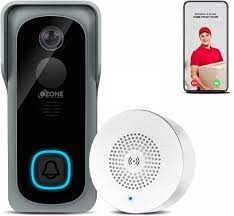The doorbell is a small yet essential device that plays a significant role in our daily lives. It serves as a convenient means of alerting us when someone is at the entrance of our homes or offices. Whether it’s a friend, a delivery person, or a visitor, the doorbell allows us to be promptly notified and respond accordingly.
Gone are the days of traditional door knockers or simply shouting to get someone’s attention. With the advent of technology, doorbells have evolved into sophisticated devices that offer various features and functionalities to enhance our security and convenience.
One of the most popular types of doorbells today is the wireless doorbell. Unlike their wired counterparts, wireless doorbells do not require complex installation procedures or drilling holes in walls. They are easy to set up and can be placed anywhere within range, providing flexibility in positioning and eliminating the need for extensive wiring.
Wireless doorbells come with a range of features designed to cater to different needs. Many models offer adjustable volume levels, allowing you to customize the sound according to your preference. Some even have multiple chime options, enabling you to select different melodies for different entrances or events.
Another notable feature found in modern doorbells is video functionality. Video doorbells incorporate cameras that allow you to see who is at your doorstep before answering the door. This added layer of security provides peace of mind, especially when it comes to identifying potential intruders or verifying the identity of delivery personnel.
Video doorbells often come equipped with motion sensors as well, which can send alerts to your smartphone or other connected devices when someone approaches your front entrance. This feature proves particularly useful when you are away from home but still want to monitor any activity around your doorstep.
Furthermore, many video doorbell systems offer two-way audio communication. This means that not only can you see who is at your doorstep, but you can also speak with them directly through your smartphone or a dedicated monitor. This feature allows for seamless interaction, whether it’s instructing a delivery person where to leave a package or simply greeting a visitor when you’re unable to physically answer the door.
In addition to wireless and video capabilities, some doorbells can be integrated with smart home systems. This integration enables you to control and monitor your doorbell remotely through voice commands or smartphone apps. You can even sync it with other smart devices like lights or security cameras for a comprehensive home automation experience.
Overall, the humble doorbell has come a long way from its basic function of alerting us to someone’s presence at our doorstep. With wireless technology, video capabilities, and smart home integration, doorbells have become an integral part of our security systems and daily routines. Whether it’s ensuring our safety or providing convenience, the modern doorbell continues to evolve and adapt to meet our changing needs in an increasingly connected world.
7 Common Questions About Doorbell Installation, Types, Wiring, and Customization
- How do I install a doorbell?
- What type of doorbell should I buy?
- How do I wire a doorbell?
- How does a wireless doorbell work?
- What are the different types of doorbells available?
- How do I replace my old doorbell with a new one?
- Can I customize the sound of my doorbell chime?
How do I install a doorbell?
Installing a doorbell can be a relatively simple process, especially if you opt for a wireless doorbell system. Here’s a step-by-step guide to help you install a basic doorbell:
- Choose the location: Decide where you want to install the doorbell button on the exterior of your home. It is typically placed near the front entrance at a height that is easily reachable.
- Prepare the tools: Gather the necessary tools, including a screwdriver, drill (if required), screws, and wall anchors (if needed).
- Turn off power (if applicable): If you are installing a wired doorbell that requires electrical connections, turn off the power supply from the circuit breaker before proceeding.
- Mount the button: If using a wired doorbell, remove any existing button and wires from the previous installation. Connect the wires to the new doorbell button and mount it securely on the chosen location using screws or adhesive.
- Prepare for wiring (if applicable): For wired doorbells, you may need to drill holes in walls or use existing wiring channels to route the wires from the button to your indoor chime unit or transformer location.
- Install chime unit/transformer: For wireless doorbells, skip this step as they do not require an indoor chime unit or transformer. If using a wired system, locate an appropriate spot indoors for your chime unit or transformer and mount it securely on a wall using screws or adhesive.
- Connect wiring (if applicable): For wired systems, connect one end of the wire from your doorbell button to the corresponding terminal on your chime unit or transformer. Repeat this process for any additional wires present.
- Test functionality: Once all connections are made, turn on power (for wired systems) and test your newly installed doorbell by pressing the button outside while listening for sound inside. Adjust volume settings if necessary.
- Secure loose wires (if applicable): If you have any exposed wires, use wire clips or electrical tape to secure them neatly along the wall or inside wiring channels.
- Adjust settings (if applicable): If your doorbell has adjustable settings such as volume levels or chime melodies, follow the manufacturer’s instructions to customize them according to your preferences.
Remember to always refer to the specific instructions provided by the manufacturer of your doorbell system for accurate installation guidance. If you are unsure about electrical connections or drilling holes, it is recommended to consult a professional electrician for assistance.
What type of doorbell should I buy?
When choosing a doorbell, there are several factors to consider based on your specific needs and preferences. Here are some key points to help you decide on the type of doorbell that would be best for you:
- Wired or Wireless: Decide whether you prefer a wired or wireless doorbell system. Wired doorbells require installation and wiring, which may be more suitable for new constructions or when replacing an existing wired system. On the other hand, wireless doorbells are easier to install and offer more flexibility in terms of placement.
- Range: Consider the range of the doorbell system. Ensure that the doorbell’s range is sufficient to cover the distance between your front entrance and where you intend to place the receiver or chime unit inside your home or office.
- Sound Options: Determine if having different sound options is important to you. Some doorbells offer a variety of chimes or melodies to choose from, allowing you to customize the sound according to your preference.
- Volume Control: Check if the doorbell has adjustable volume levels. This feature can be useful in situations where you need a louder sound in larger spaces or quieter settings during nighttime hours.
- Video Capability: If enhanced security is a priority for you, consider investing in a video doorbell with built-in cameras. Video doorbells allow you to see who is at your doorstep through your smartphone or other connected devices, providing an added layer of convenience and safety.
- Motion Detection: Look for doorbells with motion sensors if you want to receive alerts when someone approaches your front entrance, even if they don’t ring the bell directly. This feature can be valuable for monitoring activity around your doorstep when you’re away from home.
- Two-Way Audio: Consider whether two-way audio communication is important to you. With this feature, you can speak with visitors at your doorstep through your smartphone or dedicated monitor, allowing for seamless interaction even when you’re not physically present.
- Smart Home Integration: If you have a smart home system or plan to invest in one, check if the doorbell is compatible with your existing setup. Integration with smart home devices can offer additional functionalities and control options.
- Budget: Set a budget for your doorbell purchase. Prices can vary depending on the features and capabilities of the doorbell system, so it’s essential to determine how much you are willing to spend.
By considering these factors, you can narrow down your options and choose a doorbell that best suits your requirements, whether it’s a basic wireless model or a more advanced video doorbell with smart home integration.
How do I wire a doorbell?
Wiring a doorbell is a relatively simple process that can be done by following these steps:
Gather the necessary tools and materials: You will need a doorbell kit, which typically includes a doorbell button, a transformer, and wiring. Additionally, you will need wire strippers, electrical tape, and a screwdriver.
Turn off the power: Before starting any electrical work, it’s crucial to turn off the power supply to the area where you will be working. Locate the correct circuit breaker in your electrical panel and switch it off.
Mount the doorbell button: Choose a suitable location for your doorbell button near your front entrance. Use screws or adhesive to securely mount it on the wall or door frame.
Install the transformer: Locate an appropriate location near an electrical outlet to install the transformer. The transformer converts the high voltage from your home’s electrical system to low voltage required for the doorbell operation. Use screws or adhesive to mount it securely.
Connect wires to the transformer: The transformer will have two terminals labeled “Input” or “Primary” for connecting to your home’s electrical supply and two terminals labeled “Output” or “Secondary” for connecting to the doorbell button.
– Strip about 1/2 inch of insulation from both ends of one of the provided wires.
– Connect one end of this wire to one of the “Input” terminals on the transformer.
– Connect the other end of this wire to one of the two terminals on your home’s electrical supply (typically black).
– Repeat this process with another provided wire, connecting one end to another “Input” terminal on the transformer and its other end to another terminal on your home’s electrical supply (typically white).
Connect wires from button to transformer: Take another set of provided wires and strip about 1/2 inch of insulation from both ends.
– Connect one end of one wire to one of the two terminals on the doorbell button.
– Connect the other end of this wire to one of the “Output” terminals on the transformer.
– Connect one end of the second wire to the remaining terminal on the doorbell button.
– Connect the other end of this wire to the remaining “Output” terminal on the transformer.
Secure and insulate connections: Ensure all connections are secure by tightening any screws or terminals. Use electrical tape to insulate and cover any exposed wires or connections.
Restore power: Once all connections are secure, return to your electrical panel and switch on the circuit breaker that supplies power to your doorbell.
Test your doorbell: Press the button to test if your doorbell is functioning correctly. You should hear a chime or sound from inside your home.
Remember, if you are unsure about any step or lack experience with electrical work, it is always recommended to consult a professional electrician for assistance and guidance. Safety should be a top priority when working with electricity.
How does a wireless doorbell work?
A wireless doorbell operates using radio frequency (RF) technology to transmit signals from the doorbell button to the receiver inside your home or office. Here is a general overview of how a wireless doorbell works:
- Doorbell Button: The doorbell button, typically installed near your front entrance, consists of a small transmitter. When pressed, it sends a signal wirelessly to the receiver unit.
- Transmitter: The transmitter in the doorbell button converts the mechanical action of pressing the button into an electrical signal. This signal is then encoded and transmitted using radio waves.
- Radio Waves: The encoded signal is sent as radio waves at a specific frequency (usually within the range of 300 MHz to 900 MHz). These radio waves travel through the air and do not require any physical wiring.
- Receiver Unit: Inside your home or office, you have a receiver unit that is connected to an electrical outlet. This receiver unit acts as a receiver for the radio waves sent by the doorbell button.
- Signal Reception: The receiver unit picks up the radio waves within its range and decodes them back into an electrical signal that can be understood by the device.
- Chime or Alert: Once decoded, the electrical signal triggers a chime or alert sound from the receiver unit. Some wireless doorbells offer multiple chime options, allowing you to select different melodies or tones.
It’s important to note that wireless doorbells have a limited transmission range, typically between 100 to 300 meters depending on environmental factors such as walls and interference from other devices operating on similar frequencies.
Wireless doorbells are generally easy to install since they do not require complex wiring like traditional wired doorbells. They offer flexibility in terms of placement and can be moved around within their transmission range if needed.
In summary, a wireless doorbell uses RF technology to transmit signals wirelessly from the doorbell button to the receiver unit inside your home or office. This technology allows for convenient and flexible operation without the need for physical wiring.
What are the different types of doorbells available?
There are several types of doorbells available on the market today, each offering unique features and functionalities. Here are some of the most common types:
- Wired Doorbells: These doorbells are connected to your home’s electrical wiring system. They typically require professional installation and may involve drilling holes to run wires through walls. Wired doorbells usually have a transformer that converts the high voltage from your home’s electrical system to a lower voltage suitable for the doorbell.
- Wireless Doorbells: As mentioned earlier, wireless doorbells have become increasingly popular due to their ease of installation and flexibility. They operate using radio frequency or Wi-Fi signals to transmit the alert from the button at your front door to the receiver inside your home. Wireless doorbells often come with a range of chime options and adjustable volume levels.
- Video Doorbells: Video doorbells incorporate a camera that allows you to see who is at your doorstep in real-time, either through a dedicated monitor or via a smartphone app. These doorbells often have built-in motion sensors, night vision capabilities, and two-way audio communication, enabling you to speak with visitors remotely.
- Intercom Doorbells: Intercom doorbells provide audio communication between the front entrance and multiple locations within your home or office. They typically consist of an outdoor unit with a speaker and microphone, as well as indoor units placed in different rooms or areas.
- Musical Doorbells: Musical doorbells offer a wide range of chime options, allowing you to select different melodies or tunes for different entrances or events. Some musical doorbells even allow you to upload custom sounds or songs.
- Smart Doorbells: Smart doorbell systems integrate with your smart home ecosystem, allowing you to control and monitor them remotely using voice commands or smartphone apps. These doorbells often offer features like video streaming, motion detection, cloud storage for recordings, and compatibility with other smart devices like lights or security cameras.
- Traditional Mechanical Doorbells: Although less common nowadays, traditional mechanical doorbells are still available. They typically consist of a metal bell and a pull-string mechanism that you manually operate to produce the ringing sound.
When choosing a doorbell, consider factors such as your specific needs, installation requirements, budget, and desired features. It’s always a good idea to research different models and read customer reviews to find the doorbell that best suits your requirements.
How do I replace my old doorbell with a new one?
Replacing an old doorbell with a new one is a relatively simple process. Here’s a step-by-step guide to help you through the installation:
- Gather the necessary tools: Before you begin, make sure you have the following tools handy: a screwdriver (usually a Phillips-head), wire strippers, electrical tape, and possibly a voltage tester.
- Turn off the power: Locate the circuit breaker or fuse box in your home and turn off the power supply to the doorbell circuit. This step is crucial to ensure your safety during the installation process.
- Remove the old doorbell: Unscrew the mounting screws that hold your old doorbell in place. Carefully disconnect any wires attached to it while keeping track of which wire connects to which terminal. If needed, use a voltage tester to confirm that there is no electrical current running through the wires.
- Prepare the new doorbell: Read and follow the manufacturer’s instructions provided with your new doorbell for any specific guidelines or wiring diagrams. If necessary, attach any mounting brackets or plates included with your new doorbell.
- Connect the wires: Take note of how the wires were connected to your old doorbell and replicate this connection with your new one. Typically, there will be two wires: one connected to the transformer (usually labeled “TRANS”) and another connected to the front or rear door (labeled “FRONT” or “REAR”). Strip about 1/2 inch of insulation from each wire end using wire strippers if needed.
- Attach the new doorbell: Align your new doorbell with its mounting bracket or plate and secure it in place using screws provided by the manufacturer.
- Test and adjust settings: Once everything is securely installed, restore power to the circuit by turning on the corresponding breaker or fuse in your electrical panel. Test your new doorbell by pressing its button and confirming that it rings properly. Adjust any volume or chime settings according to your preferences, following the instructions provided with your new doorbell.
- Secure and tidy up: After testing, make sure all connections are secure and properly insulated. Use electrical tape to wrap the exposed wire ends, ensuring they are covered and protected.
Remember, if you are unsure about any step or encounter unfamiliar wiring situations, it’s always best to consult a professional electrician for assistance. Safety should be your top priority when working with electrical systems.
Can I customize the sound of my doorbell chime?
Yes, many doorbell models offer the option to customize the sound of your doorbell chime. This feature allows you to choose from a variety of melodies or tones that best suit your preferences. Some doorbells even provide a library of pre-set chimes, ranging from traditional doorbell sounds to more contemporary tunes.
To customize the sound of your doorbell chime, you typically need to access the settings on your doorbell device. This can be done through a dedicated smartphone app, a control panel, or directly on the device itself, depending on the model.
Once you access the settings, you will usually find options to select different chimes or melodies. Simply browse through the available choices and choose the one that appeals to you the most. Some advanced models even allow you to upload your own custom sounds or music files.
Remember to test each chime selection before finalizing your choice. Consider factors such as volume levels and clarity to ensure that it can be heard clearly throughout your home or office space.
Customizing the sound of your doorbell chime adds a personal touch and allows you to select a tone that matches your style and preferences. Whether you prefer a classic ding-dong sound or a more unique melody, having control over your doorbell’s chime enhances both functionality and aesthetic appeal.




